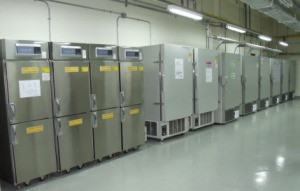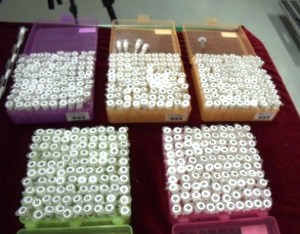DNA bank
.jpg) View publication on DNA banks by clicking on the icon above. (0.1 MB) |
Page compiled by: ILRI, Addis Ababa, Ethiopia (Jean Hanson); Bioversity International/ILRI, Addis Ababa, Ethiopia (Alexandra Jorge).
The use of DNA banks
Molecular techniques are becoming increasingly important in the study and management of genetic resources. DNA has been routinely extracted and stored from the nuclei, mitochondria and chloroplasts of many plant species, together with derivatives such as RNA, cDNA and genes. Technologies are available to allow all these to be stored quickly and at low cost in DNA banks as an insurance policy against loss of crop diversity. DNA storage has so far been undertaken with objectives other than conservation in mind; usually to allow genetic material to be made readily available for molecular applications, for distribution or training.
DNA banks can now be considered as a means of complimentary conservation. DNA storage is particularly useful for those species that cannot be conserved in traditional seed or field genebanks and nor conserved in situ due to high risk in that area. Although to date there are no cases where DNA banks have been assembled to specifically replace traditional methods of conserving genetic resources, the potential for DNA storage is promising due to the small sample size for storage of genetic information and the stable nature of DNA in cold storage. However, use of DNA banks in conservation is limited as whole plants cannot be directly reconstituted from DNA nor are the original genotypes recovered. The genetic material must first be introduced artificially, through transformation or transduction using plasmids or liposomes, back into somatic cells that can then be grown into whole plants in in vitro culture.
The field of molecular biology is advancing rapidly. As new techniques are developed DNA banks are likely to become a more feasible option for conservation of crop diversity in the future. For more information on the options for DNA banking see DNA Banks.
|
|
|
|
| Vials used to store DNA samples at low temperature (photo: Bioversity/ILRI, by kind permission of RDA genebank, National Agrobiodiversity Center, Suwon, Republic of Korea) |
Advantages
DNA banking is an efficient, simple and long-term method to conserve the genetic information.
Disadvantages
There are problems with subsequent gene isolation, cloning and transfer of DNA back to a plant and it currently does not allow the regeneration of the same genotype as the original sample.
Practical considerations
Storage strategy
Determining what to store and for how long is an important consideration, used to determine sample size, capacity of the DNA bank, preparation of samples and documentation. Long-term needs and expected volume and number of samples to be stored will determine organization and repository design. The International Society for Biological and Environmental Repositories (ISBER) has developed a set of best practices for management of biological samples for research that provide useful guidance for DNA banks at http://www.isber.org/Pubs/BestPractices2008.pdf. Although the specifics vary with type of biological sample, many of their recommended best practices on choice of location, storage design, risk mitigation and documentation follow similar considerations to those for seed genebanks.
Processing of samples
DNA preserved in DNA banks will be stored either within cells and extracted upon retrieval from storage or extracted from cells and purified before storage. The quality of the DNA is expressed through yield, purity, molecular weight, amplification efficiency and authenticity of sequences. The quality of DNA extracted from plant specimens is dependent on the condition of the specimen before storage, the storage environment and the duration of storage. Rapid drying of plant samples with silica gel or lyophilisation helps to preserve the DNA. Plant samples can also be frozen but DNA should be extracted immediately when the samples are retrieved from frozen storage using protocols that inhibit nuclease activity. Careful and clean extraction methods are critical during processing. DNA banks should determine whether the collector or the curator is responsible for extracting DNA for storage as part of the quality control process.
Storage
Once extracted DNA is a stable biomolecule, although it can easily be degraded during extraction and storage. Quality declines within days in hydrated samples held at room temperature or in refrigerators. Drying the sample or storing it in freezers or liquid nitrogen achieves better preservation of DNA molecular size. For this reason, DNA is better conserved in a form that is close to the original state and most DNA banks store cells or tissues and extract DNA upon request.
Standard storage protocols should be developed and used and any risks and changes in environment within the storage period should be documented
References and further reading
de Vicente MC, editor. 2004. The evolving role of genebanks in the fast-developing field of molecular genetics. International Plant Genetic Resources Institute, Rome, Italy. Available here.
de Vicente MC, Anderson MS, editors. 2006. DNA banks-providing novel options for genebanks? Topical Reviews in Agricultural Biodiversity. International Plant Genetic Resources Institute, Rome, Italy. Available here.
de Vicente MC, Lopez C, Fulton T. 2004. Molecular Marker Learning Modules - Vols 1 and 2. International Plant Genetic Resources Institute, Rome, Italy. Available here.
Engels JMM, Visser L, editors. 2003. A guide to effective management of germplasm collections. IPGRI Handbooks for Genebanks No. 6. IPGRI, Rome, Italy. Available in English (1.4 MB) and Spanish (1.5 MB).
International Society for Biological and Environmental Repositories (ISBER), 2008. 2008 Best Practices for Repositories: Collection, Storage, Retrieval and Distribution of Biological Materials for Research. Second Edition. Cell Preservation Technology, 6:1-56. http://www.isber.org/Pubs/BestPractices2008.pdf
Madisen L, Hoar DI, Holroyd CD, Crisp M, Hodes ME. 1987. DNA banking: the effects of storage of blood and isolated DNA on the integrity of DNA. Am. J. Med. Genet. 27:379–390.
Spooner D, van Treuren R, de Vicente MC. 2005. Molecular markers for genebank management. IPGRI Technical Bulletin No. 10. International Plant Genetic Resources Institute, Rome, Italy. Available here.
Visvikis S, Schlenck A, Maurice M. 1998. DNA extraction and stability for epidemiological studies. Clin. Chem. Lab. Med. 36:551–555.
Comments
- No comments found







Leave your comments
Post comment as a guest